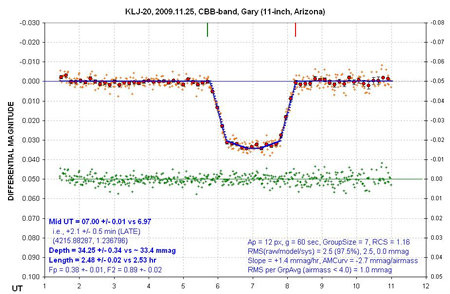Exoplanets
VIDA Postdoctoral Fellow Joshua Pepper is leading Vanderbilt's effort to discover planets around nearby stars: The Kilodegree Extremely Little Telescope (KELT).
|
KELT: Kilodegree Extremely Little Telescope The KELT project is an effort to detect transiting planets around bright stars. It consists of two telescopes, KELT-North in Arizona at Winer Observatory and operated by Ohio State University, and KELT-South, which is operated by Vanderbilt University at the South African Astronomical Observatory to cover both the northern and southern sky. The telescopes are nearly identical—with small apertures and wide fields of view to search as much of the sky as possible. KELT South was built at Vanderbilt, and tested at Dyer Observatory. Since being deployed to South Africa, KELT South has operated nearly autonomously, taking huge amounts of data (~10 Gigabytes every night) which are being searched for transiting planets. In addition, the project will discover many variable stars, such as eclipsing binary stars, which are scientifically valuable in their own right. |
The past decade has seen a revolution in our understanding of planets outside our solar system. Before 1995, there were no planets known to orbit other stars like our sun. Now we know of hunderds of planets around stars in our galaxy, most of them orbiting stars like the sun. These discoveries have drastically changed our understanding of how planets form and evolve. Many solar systems look nothing like ours, with huge gas giant planets whipping around their stars in only a few days—so close that their gaseous atmospheres are hotter than molten lead. Other systems have planets in highly eccentric orbits, swooping in close to their star and then shooting out to distances many times further away, so that the heat from the star changes by orders of magnitude during an orbit.
These planets have mostly been discovered through the radial-velocity method, in which large telescopes watch stars carefully to detect the subtle wobble back and forth of the star due to the gravitational influence of a planet. Another method for planet discovery that has shown increasing promise in recent years is called the transit method. With this technique, a relatively small telescope stares at tens or hundreds of thousands of stars over months or years and watches for a planet to pass in front of a star, eclipsing the star's light and dimming the star. The dimming is very small—the star typically dims by 1% or less, which means we need exceptionally precise observations to find planets this way. However, the payoff is huge; when a transiting planet is discovered, the planet's size and mass can be known precisely, and therefore we can find out the planets density and get an idea of its composition. You can even watch the starlight filter through the outer atmosphere of the planet and discover what the atmosphere is composed of! This technique has already been used to detect methane, sodium, and water in the atmospheres of other planets.
Vanderbilt's Kilodegree Extremely Little Telescope (KELT) project is similar to a number of projects looking for transiting planets. However, KELT is configured to search a larger area of the sky than any other project, and since it is targeting the brightest stars, the planets it discovers will be the most scientifically valuable. We are also committed to being as open as possible with the project, sharing our techniques, plans, and data with the scientific community with unprecedented flexibility. See the KELT North website, and the KELT South website for details.
After KELT detects new planet candidates, we benefit from a collaboration with astronomers at Harvard, Swarthmore, the University of Louisville, and Las Cumbres Observatory to help confirm the veracity of these planets with additional observations. We also collaborate with Mr. Bruce Gary, an avid amateur astronomer whose small telescope system is capable of cutting-edge photometric precision at the sub-millimagnitude level. The example light curve below easily detects a transit with a depth of 30 millimagnitudes. Measurements of 1-minute exposures exhibit a precision of 2.5 millimagnitude; 7-minute data averages have a precision of 1.0 millimagnitude.

